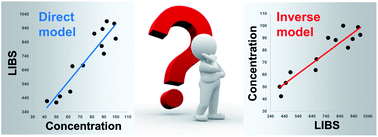Should we prefer inverse models in quantitative LIBS analysis?
Abstract
Since the 2000s, the analytical potential of laser-induced breakdown spectroscopy (LIBS) has been growing steadily. This is explained by the many advantages it provides such as its sensitivity, its speed of acquisition, but also the possibility of analyzing most samples as they are without preparation. Like many spectroscopies in the framework of quantitative analysis, LIBS uses the concept of indirect measurement to estimate the concentration of an element of interest in a given matrix. Thus, in the simplest case of univariate calibration, the emission signal at a particular wavelength is used as an input of a simple linear regression to obtain the associated concentration. This regression is one of the oldest statistical tools that can be used to make the link between two variables. On the basis of the calibration samples, the LIBS community is used to construct the function f, such as emission signal = f(concentration). With this so-called direct model, the prediction of the concentration of an unknown sample is then obtained by calculating f−1 (emission signal). This habit may be very surprising because many spectroscopies nowadays use the so-called inverse model. Thus, in this case, another function g is calculated from the same data set, such as concentration = g(emission signal). In this specific case, the function can be used directly to predict the concentration of a new sample. At first glance, we could say that this is not very important because it is the same as reversing the axis of abscissa and ordinate in a two-dimensional graph. In this paper, we will show that this choice is not insignificant because it may lead to statistical differences. Through the study of simulations and real cases, we will demonstrate that a difference in the predictive ability is observed between the direct and inverse regression in the framework of LIBS quantitative analysis.



 Please wait while we load your content...
Please wait while we load your content...